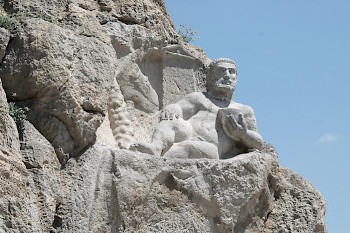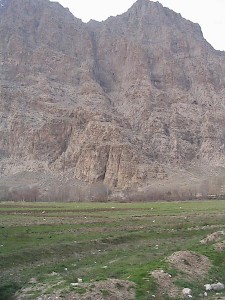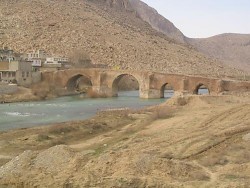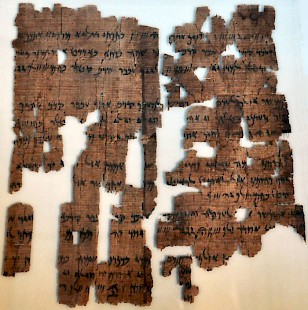Behistun (2)
Behistun or Bisotun: town in Iran, site of several ancient monuments, including a famous inscription by the Persian king Darius I the Great. The full Persian text is here.
Identification

Several ancient authors have left descriptions of the monument. The first to do so was the Greek physician Ctesias of Cnidus (ca. 400 BCE). He tells us that there are a well and a garden beneath a monument dedicated by the Assyrian queen Semiramis to the supreme god, which Ctesias calls by his Greek name Zeus. Ctesias' text is now lost, but it is quited by Diodorus of Sicily,note who also mentions Alexander the Great's visit to this place.note
Half a millennium later, the Roman historian Tacitus (ca. 55-120 CE) informs us that there was an altar for Hercules.note In 1959, this report was corroborated when a statue of the Greek demigod was found. He is quietly resting and drinking from a bowl, after performing one of his labors. Dedicated in 148 BCE, it is probably the youngest Seleucid piece of art in Iran.
After the fall of the Achaemenid Empire, the significance of the monument was forgotten, but there were later additions. There are Parthian reliefs and in the Sasanian age, a piece of rock was cleared for a relief that was never made. They are discussed here.
In the seventh century, a romantic story was told about the architect Farhad who created the monument. According to this legend, the relief shows the Sasanian king Khusrau II "the victorious" (591-628 CE) and the enemies he has defeated.
The next to describe the monument was the Arab traveller Ibn Hauqal (died 977), who thought that Darius was a teacher in front of a group of pupils. He took Darius' bow to be a whip, used to punish the boys.

In 1598, the British diplomat in Austrian service Robert Sherley traveled east, hoping to speak the Persian shah Abbas the Great about the war against Turkey. One of his servants was a Frenchman, Abel Pinson, who wrote that the caravanserai of Behistun was situated under a very high cliff on which he had seen a representation of 'the ascension of our Lord' with an inscription in Greek. It is obvious that Pinson had not seen the damaged figure of the fallen Gaumâta, and thought that the image of Ahuramazda and the twelve men represented Christ and his disciples. He was not the last to make this mistake: in 1808, a French traveler called Ange Gardane thought it represented twelve apostles standing under Jesus' cross. In 1818, the British scholar Ker Porter made the first drawing ot the monument, thinking that it was a picture of the ten tribes of the Jewish kingdom of Israel and the Assyrian king Shalmaneser.
The first serious attempt to examine the rock relief was made by Henry Rawlinson in the summer of 1835. He must have been a skilled mountaineer, because he managed to climb the cliffs several times in order to make a squeeze of the cuneiform texts. This writing system was still unintelligible, but Rawlinson had already recognized the word Dârayavauš (Darius) somewhere else, and was soon able to recognize the same letters in this monument. When he received some notes by the German scholar Georg Friedrich Grotefend, who had booked some progress in the decipherment of the Persian cuneiform alphabet, Rawlinson was able to break the code. The first lines must have been a big surprise, because Darius wrote more or less:
I am Dârayavauš the king, son of Vištâspa, of the Hakhâmanisiya-dynasty, king of kings. I am king in Pârsa. My father is Vištâspa. Vištâspa's father is Aršâma, Aršâma's father was Ariyâramna, Ariyâramna's father was Cišpiš, and Cišpiš' father was Hakhâmaniš.
This list was more identical to the list of kings in the Histories of the Greek researcher Herodotus,note where these names are given as Darius, Hystaspes, Arsames, Ariaramnes, Teispes and Achaemenes. Within two weeks Rawlinson was able to establish the meaning of all 42 signs of the old Persian alphabet.
In 1837 he returned to Bisotun, where he and an agile Kurdish boy made a new squeeze of half the Persian text, a dazzling feat of mountaineering which cost the two a year. Since Rawlinson knew the Persian language and had read the age-old sacred book Avesta, he was soon able to read the entire text and to understand grammar, syntax and vocabulary of the language of one of the three texts at the monument. In 1838 he handed over his first results to the Royal Asiatic Society in London and the Société Asiatique in Paris. Eight years later, he started to publish on the "Persian Cuneiform Inscription at Behistun, Deciphered and Translated" in the Journal of the Royal Asiatic Society.

The translation caused a sensation. It told how a Magian had occupied the Persian throne after the death of king Cambyses (Persian: Kambûjiya), claiming to be his brother Smerdis (Persian: Bardiya). Seven conspirators had discovered it and Darius, who was a relative of Cambyses, had killed the man. This confirmed one of the most unbelievable and romantic stories told by Herodotus.note In the Behistun inscription Darius also told how he had suppressed several rebellions against the Persian hegemony and how he had defeated the nomads of the Central Asian steppe against whom the legendary Persian king Cyrus the Great had fought in vain.
In 1844, Rawlinson and three colleagues again climbed the cliffs at Bisotun, now making a complete squeeze. Using this copy, the scholars Niels Westergaard and Edwin Norris managed to decipher the 131 characters of the Elamitic script and to read the old language: an impressive achievement since Elamite is a dead language, related to no known spoken tongue. Rawlinson started the decipherment of the complex cuneiform script of Babylonia (which has some 500 characters) and the Akkadian language. He succeeded in 1852; from now on, scholars were able to read the flood of clay tablets coming from the excavations at Nineveh. These opened the way to a new discipline: assyriology.

The relief was damaged during the Second World War, when soldiers used the figures as targets. The face of Ahuramazda is now completely destroyed.
Literature
- Ann Fawkers, "The Behistun relief" in: Ilya Gershevitch (ed.): The Cambridge History of Iran, vol. II: The Median and Achaemenian Periods, 1985 Cambridge, pages 828-831
- P. Lecoq, "Un problème de religion achéménide: Ahura Mazda ou Xvarnah?" in: Orientalia J. Duchesne-Guillemin emerito oblata, 1984 Leiden, pages 301-326
- Rüdiger Schmitt, The Bisitun Inscriptions of Darius the Great. Old Persian Text (Corpus Inscriptionum Iranicarum, Part I: Inscriptions of Ancient Iran. Volume I, The Old Persian Inscriptions; Texts 1.) 1991 London.